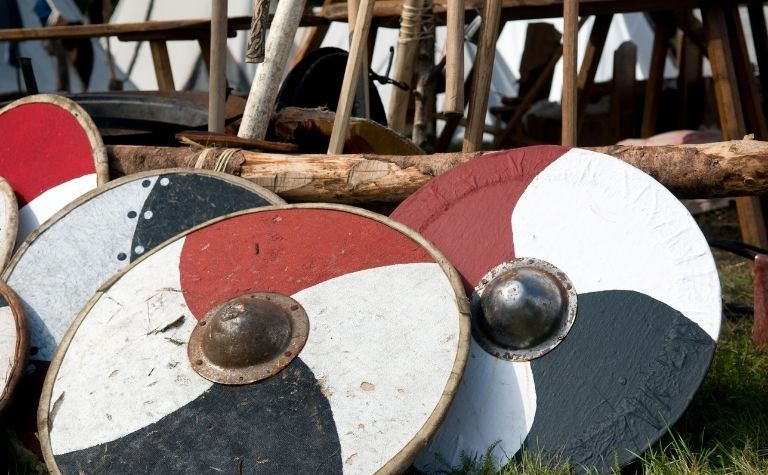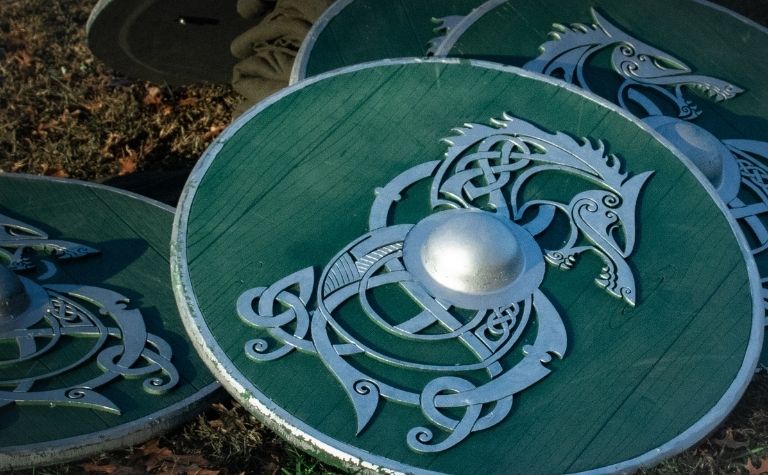While weapons like swords and axes may have received all the hype and attention as the Vikings marched throughout Northern Europe on their raids and conquests, their simple wooden shields played a significant role in their military successes.
Viking shields were uniquely adapted for the fighting styles and military objectives of the legendary warriors who used them.
Every aspect of the design of Viking shields had a purpose, including:
- They were round to make them highly maneuverable
- They were painted to protect the wood planks
- They were emblazoned with patterns to identify their allegiance
In spite of their reputation as bloodthirsty savages, the Vikings were savvy tacticians and highly resourceful strategists.
Their selection and use of weapons catered to their unique strengths and objectives.
And just like the Vikings themselves, their shields were purpose-driven implements designed to intimidate, surprise, and ultimately, conquer. Here’s how.

The Shape of Viking Shields
When it comes to the military arsenal of the famed Norse warriors from Scandinavia, one of the most recognizable pieces is the iconic Viking shield with its signature circular shape.
Crafted from local wood like pine and linden, Viking shields were considerably smaller than those used elsewhere in Europe during medieval times. (Also see Did Female Vikings Go On Raids?)
But there was no design flaw. In fact, their compact size and other key attributes, including most notably their round shape, made shields a vital part of the military arsenal of the Vikings for several centuries:
- Viking shields were circular in shape and typically measured 24 to 38 inches (60 to 90 cm) in diameter, depending on the size of the warrior
- Laminated wood planks were glued or held together with braces
- Viking shields were held from the center by gripping a bar running across a hole cut in the wood (the wearer’s hand was protected by a metal dome, known as the “boss”, fastened to the outside of the shield) [1]
Being lightweight and measuring no more than three feet (one meter) across, Viking shields would not have provided much defense against a direct blow from a sword or axe.
However, that is not what they were intended for; rather, Viking shields were meant to be wielded with one hand and moved about to deflect and absorb strikes.
Furthermore, they could even be used for offensive purposes.
The fact that all edges of the shield were equidistant from the handle meant that the gripping hand served as a pivot point, providing nimble movement and lightning-fast maneuverability, which coupled with the combat savviness and fearless attitude of Viking warriors, would have made for a lethal combination in battle. [2] (Also see Is Valhalla Heaven or Hell?)
Eventually, circular Viking shields were joined by kite-shaped versions that by many accounts were an innovation of the Normans, who were direct descendants of Vikings who invaded western France and were eventually given their own territory. [3]
So-called kite shields were also lightweight but provided greater protection for the lower body and legs. (Also see 6 Reasons the Vikings Invaded Britain)

The Color of Viking Shields
While Viking swords and axes may grab all the headlines as artifacts recovered from ancient sites, some of the most stunning archeological finds from the Viking Age have been shields.
For instance, the famed Gokstad ship that was discovered in Norway featured, among other grave goods, 64-round Viking shields. [4]
Upon close analysis, scientists observed traces of yellow and blue paint adorning the wood. (Also see Did Vikings Really Burn Their Ships?)
Scholars have long known that the Vikings did not live in a drab, colorless world, but rather, were quite fond of bright colors and used them in many aspects of their lives.
Until recently, all that was known about the Vikings’ color preferences came from sources like tapestries, illustrations, and descriptions.
This is particularly true for items made from wood, which decomposes over time, leaving very little material for scientists to examine. [5] (Also see 15 Facts About Viking Women)
How Did Vikings Color Their Shields?
Upon subjecting trace amounts of pigments recovered from various artifacts to chemical analysis, scientists have been able to identify a dozen or so colors that they believe were used by the Vikings to paint various items.
These findings also indicate the natural resources that were used to produce the Viking palette of colors. [6] For instance:
- Naturally occurring minerals and materials were used to produce pigments such as malachite to produce green pigment, iron oxide for shades of red, and vivianite for bluish hues
- To bond the pigments to the surface being painted, they were mixed with binding agents that were fashioned from dairy products, eggs, and linseed oil
- The National Museum of Denmark has identified a dozen or so colors that it believes were prominently used during the Viking Age
Now that we know how the Vikings made color dyes, let’s take a look at what each of the colors represented to them. (Also see Did the Vikings Worship Odin?)
What Did Each Color Symbolize to Vikings?
The Vikings had a preference for bold, vibrant colors and this was likely reflected in the color schemes of their shields.
Like so many facets of Norse culture, each color used by the Vikings had its own meaning, as exemplified by:
- Green symbolizes hope
- Red meant strength, and sometimes danger or hostility
- White was the color of life, neutrality, and innocence
- Black was associated with death
Whether they were painted yellow, blue, or any other hue, the sight of Viking warriors advancing, with their colorful shields clutched in their hands, must have been an imposing one.
And if those shields happened to be painted red or black, then in all likelihood, the legendary fury of the Vikings was soon to be unleashed with lethal results.
Patterns on Viking Shields
In addition to various color schemes, the Vikings also adorned their shields with patterns such as pinwheel designs, crosses, and even inscriptions, most notably with ancient Norse runes.
Norse Runes were far more than mere decorations, in many cases, they signified or symbolized various meanings. For instance:
- They were a show of allegiance to a clan or leader
- They indicated the bearer’s rank or stature [7]
Often, elaborately painted shields served a ceremonial purpose or were used as adornments on Viking longships.
In other instances, these implements of war bore messages or prayers to Norse deities in the form of runes that were carefully inscribed on the wood planks.
Famed Viking warriors known as berserkers famously engraved the rune characters for Tyr, the Norse god of warfare, on their shields believing that their shields would provide a divine measure of protection. [8] (Also see 25 Norse Gods to Know)
As a practical matter, painting color schemes, patterns, or inscriptions on shields served as a varnish or sealant on the surface of the wood, thereby providing shields some measure of protection against the damaging effects of moisture. [9]
Final Thoughts
For two and a half centuries, the Vikings were a dominant force in Northern Europe and their shields were a large part of that success.
References:
[1] Source
[2] Source
[3] Source
[4] Source
[5] Source
[6] Source
[7] Source
[8] Source
[9] Source
